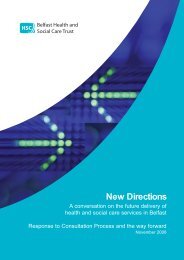Examination under anaesthetic, ± laparoscopy
Examination under anaesthetic, ± laparoscopy
Examination under anaesthetic, ± laparoscopy
You also want an ePaper? Increase the reach of your titles
YUMPU automatically turns print PDFs into web optimized ePapers that Google loves.
To accompany DHSSPS Consent Form 2 Impalpable testis Page 1 of 2Name of Operation: <strong>Examination</strong> <strong>under</strong> <strong>anaesthetic</strong>,<strong>±</strong> <strong>laparoscopy</strong> (camera examination via a “key-hole”),<strong>±</strong> orchidopexy (bringing testicle down to scrotum, sometimes in stages)Main issues:If the testicle is felt in a normal position <strong>under</strong> <strong>anaesthetic</strong>, then no surgery is needed.If the testicle is felt in the groin, we then do an open operation (“orchidopexy”) withthe aim of bringing the testicle down to the bottom of the scrotum in one go.If the testicle cannot be felt, then we pass a camera into the tummy via the bellybutton.If this shows the testicle is buried in the groin, then we do an openorchidopexy (as above). If the camera shows the testicle is “stuck” inside the tummy,then we do a “laparoscopic first-stage orchidopexy” (freeing up the testicle using thecamera and instruments via 2 more “key-holes,” so that it is no longer stuck, butleaving it inside the tummy for now, so as to reduce the risk of the fragile testiclegetting damaged). This is then followed in about 6 months by another key-holeoperation, hoping to bring the testicle down into the scrotum.Sometimes no testicle is found, or it is so poorly developed that it will never work, soit is safer to remove it (risk of future tumour in it). This is not serious, as both pubertyand fertility are usually normal with only 1 testicle. However, in that case, we usuallyrecommend securing the other testicle in the scrotum, at the same operation, toprotect it from the small (but very serious) risk of possible damage in the future.Position of possible wounds.Dissolving stitches.Likely post-operative schedule and recovery-time.Intended benefits:Easier detection in unlikely event of future testicular problems.Cosmetic (improved appearance).The increased (but still small) risk of cancer in a testicle inside the tummy may bereduced by bringing it down into the scrotum.This operation probably has no benefit for future fertility.Common or serious risks:Bleeding (rarely serious).Infection (rarely serious).Mr. David Marshall, Consultant Paediatric Surgeon/Urologist, RBHSC Version 7 (Dec 11)
To accompany DHSSPS Consent Form 2 Impalpable testis Page 2 of 2Common or serious risks (cont’d):Damage to the testicle, its circulation, sperm-tube, bowel, or bladder (rarely serious).Very occasionally the testicle may become completely disconnected from its tubing,and the procedure has to be abandoned.Being unable to carry on with (or to finish) the operation, due to unexpected technicalproblems with the equipment on the day. The operation may then need repeatedanother day.Being unable to get the testicle all the way down to the bottom of the scrotum:sometimes another operation may be needed at least 6 months later.Despite a successful operation, the testicle can pull up into the groin as healingoccurs over the next year or so. Another operation may be needed.Overall success-rate from staged-orchidopexy is about 60% (6 out of 10). In theother 40% (4 out of 10), the freeing up of the stuck testicle leads to its circulationfailing, and it shrivels up, either in the tummy (between the 1 st - and 2 nd -stageoperations) or in the scrotum (after the 2 nd -stage operation).A hernia (lump in the groin) developing, needing another operation (rare).Poor healing of the wound: unusual, but very occasionally may need later surgery.Nerve-pain, even for many years afterwards (very rare).Anaesthetic problems (rarely serious, but around 1 in 250,000 general <strong>anaesthetic</strong>s inchildren can be fatal).A diagram showing the wounds, and the testicle brought down from groin to scrotumMr. David Marshall, Consultant Paediatric Surgeon/Urologist, RBHSC Version 7 (Dec 11)
















